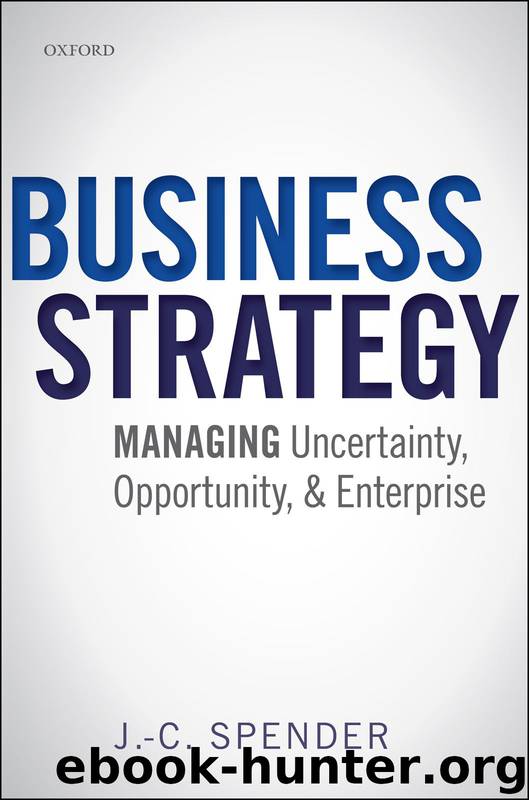Business Strategy: Managing Uncertainty, Opportunity, and Enterprise by J.-C. Spender

Author:J.-C. Spender [Spender, J.-C.]
Language: eng
Format: epub
Publisher: Oxford University Press
Published: 2014-01-30T00:00:00+00:00
4.2 Mise en Place
Chefs learn to prepare for action, collecting pots, sharpening their knives, setting out the recipe’s ingredients, heating the oven, and so on. Strategic work is similar—and the tools inventoried in Chapters 2 and 3 can be seen as recipe book entries. But when cooking, process is everything. The result is dominated by the chef’s strategic judgments. Just so for the strategist, for a situation never presents as complete and coherent, more as a buzzing booming confusion of experiences, impressions, possibilities, relationships, etc. The first part of strategic work is labeling, distinguishing, and selecting what matters from what does not. There is a chicken and egg problem. When the BM is in place it labels and indicates what matters and what does not—but without it how is the strategist to know for sure? Experience might suggest what matters; that the past shows the appropriate way into the present task. But what about doubt? Maybe this time is different and if we remain bound by experience we cannot cut ourselves free of the past and move forward into a new world changed to make it our own. Sometimes experience is a crutch to be tossed aside if something truly innovative is to happen. Research suggests, for instance, that people who have been entrepreneurs before are more likely to succeed than those trying for the first time. Rather than know what to pay attention to in the new situation, perhaps they know how to cut themselves loose from their assumptions and overcome doubt. Then again, sometimes the old hands get it wrong and youth and inexperience gets its turn. But note also that the strategist is never concerned with averages or statistics but is always focused on succeeding in a particular situation.
Each of the BMs discussed in Chapters 2 and 3—SWOT, BCG, TCE, principal-agent, and so on—has usable components or elements. What do components look like? Can some be used again? Instead of looking for a completely novel BM, “rolling our own,” some of these might be recycled as components or axioms with which to construct the new BM. Axioms are the ideas that underpin a discourse. SWOT’s axioms are both subtle and flexible—which is why it remains so useful and popular. First, there is the concept of the firm as something that exists, distinct and separable from its environment. While this seems a self-evident truth, a real firm’s boundaries are not so obvious, indeed some now talk of the “boundary-less” firm or an “open source network” of value-adding relationships. But note that when the firm is a discrete economic unit, it can possess “things,” less clear when it is a network that stretches out to stakeholders and the public affected by the firm’s operations. In a capitalist system resource possession is crucial to capturing the value created. We presume the things possessed include assets of tangible and intangible types, such as a factory with some defined production capacity plus the skills hired to work it, or a patent, or a market share, or a reputation.
Download
This site does not store any files on its server. We only index and link to content provided by other sites. Please contact the content providers to delete copyright contents if any and email us, we'll remove relevant links or contents immediately.
Bad Blood by John Carreyrou(6515)
Rich Dad Poor Dad by Robert T. Kiyosaki(6352)
Principles: Life and Work by Ray Dalio(6166)
Playing to Win_ How Strategy Really Works by A.G. Lafley & Roger L. Martin(5846)
Management Strategies for the Cloud Revolution: How Cloud Computing Is Transforming Business and Why You Can't Afford to Be Left Behind by Charles Babcock(4508)
The Confidence Code by Katty Kay(4172)
Thinking in Bets by Annie Duke(4139)
American Kingpin by Nick Bilton(3735)
Delivering Happiness by Tony Hsieh(3352)
Project Animal Farm: An Accidental Journey into the Secret World of Farming and the Truth About Our Food by Sonia Faruqi(3161)
The Power of Habit by Charles Duhigg(3043)
Brotopia by Emily Chang(2985)
The Tyranny of Metrics by Jerry Z. Muller(2978)
Mastering Bitcoin: Programming the Open Blockchain by Andreas M. Antonopoulos(2964)
The Marketing Plan Handbook: Develop Big-Picture Marketing Plans for Pennies on the Dollar by Robert W. Bly(2946)
I Live in the Future & Here's How It Works by Nick Bilton(2919)
The Content Trap by Bharat Anand(2850)
Applied Empathy by Michael Ventura(2825)
Building a StoryBrand by Donald Miller(2825)
